There have been several threads over the years where people have asked what's inside these old Opamp Labs cans. I had a couple of noisy 425s and decided to donate them to science. Thought I'd share what i came up with.
The 425 is shown in schematics on the OL web site as an output stage/line driver, often with mic pres like the 360x series in front of them. It's also documented as a standalone mic preamp, a summing amp, and a makeup gain stage in limiter circuits. It's a pretty versatile little module.
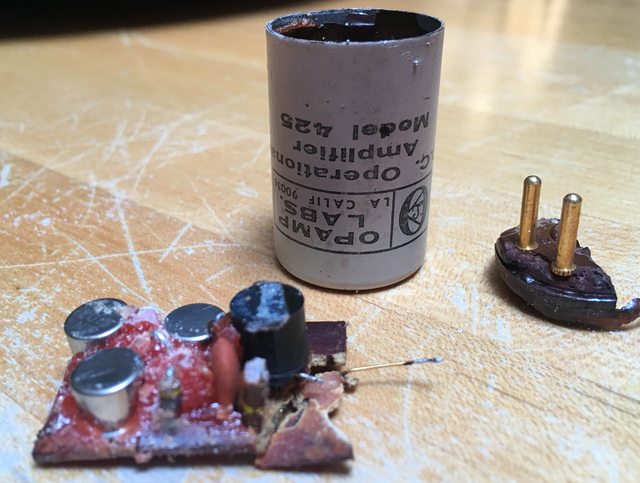
The pink epoxy potting is nasty and refuses to melt. Instead, it just gets darker and crumbles when heated enough. Hard to get all of it off the board without melting the plastic components. Had a heck of a time getting this one apart, and I tore the edge of the circuit board off trying to pull it out. Due to the damage and the residue left on the underside, I've not been able to completely trace it out. I plan to do that with the second unit now that I know what I'm dealing with - hoping I can get that one out more cleanly.
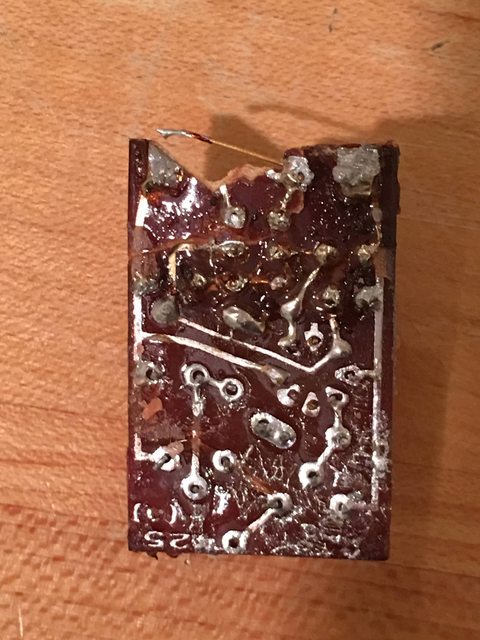
Also, some of the active components aren't marked. But it's easy enough to see what's going on. A hybrid circuit like many of the late 60s/early 70s, with what looks like an 8 pin proprietary opamp (I believe it's the Opamp Labs 4009; see picture of that unit below), with a matched pair of BJTs on the input (the black, 6 pin cylinder) and a complimentary pair on the output. The 4009 is the shorter round metal can. You can see on the underside in the picture above that it's got 8 pins.

OL 4009 proprietary opamp (from web source - the one in this module is not labelled):
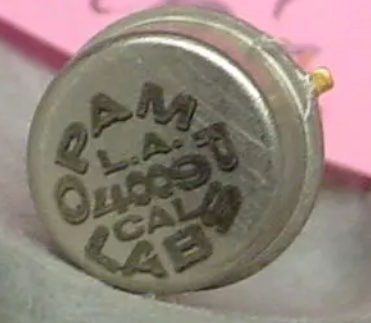
Differential input stage looks like one of the old Sprague TD series matched duals. I've had a few of the TD-101's around for years (pic below). The owner/guru at the local (old school, fantastic) electronics shop here told me he thinks Sprague just binned maybe BC-54x - BC-55x transistors and matched hFE & Vbe, then encased them in resin. Nothing like the super matched stuff in the LM394 or MAT parts, but very useful nonetheless.
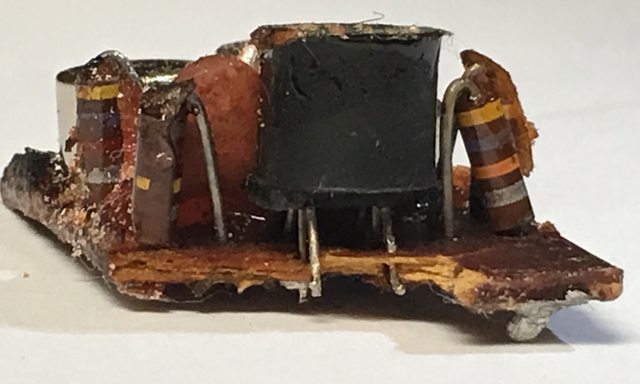
TD-101s from my stash:
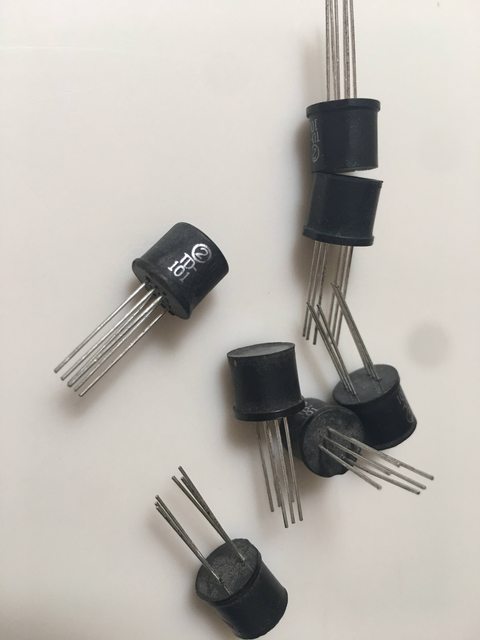
One of the output transistors is marked. It's a 2N2102, used on so many discrete output stages of the era. The PNP of the pair is not marked, but it's probably a 2n4036, as that combination was very common back then. The rest is passive stuff. The white parts look like they might be diodes or inductors, maybe?
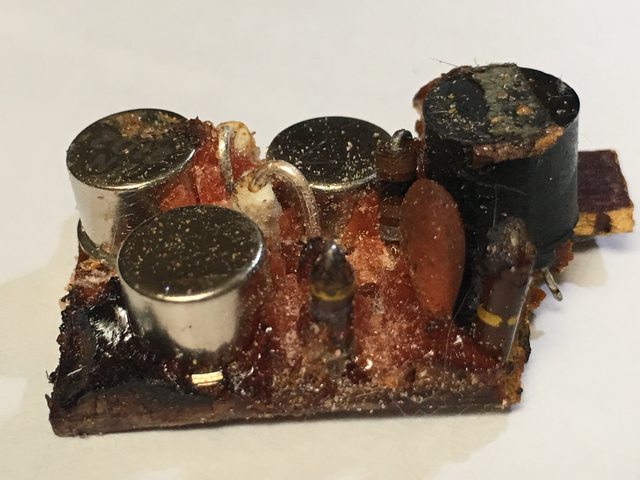
I seem to recall Scott Dorsey posting on another forum (maybe the old rec.proaudio board?) that the 360xx mic pres were just a 425 with a Beyer peanut transformer on the input. That seems credible enough. IIRC, he had (has?) a full OL console in his studio, which he bought from Norman Lear productions (TV shows from the 60s/70s).
It's crazy that you can still buy these things brand new directly from OL. Last time I looked they were still around $40 each, which is cheaper than most of the used stuff on evilbay.
Enjoy.
BT
The 425 is shown in schematics on the OL web site as an output stage/line driver, often with mic pres like the 360x series in front of them. It's also documented as a standalone mic preamp, a summing amp, and a makeup gain stage in limiter circuits. It's a pretty versatile little module.

The pink epoxy potting is nasty and refuses to melt. Instead, it just gets darker and crumbles when heated enough. Hard to get all of it off the board without melting the plastic components. Had a heck of a time getting this one apart, and I tore the edge of the circuit board off trying to pull it out. Due to the damage and the residue left on the underside, I've not been able to completely trace it out. I plan to do that with the second unit now that I know what I'm dealing with - hoping I can get that one out more cleanly.

Also, some of the active components aren't marked. But it's easy enough to see what's going on. A hybrid circuit like many of the late 60s/early 70s, with what looks like an 8 pin proprietary opamp (I believe it's the Opamp Labs 4009; see picture of that unit below), with a matched pair of BJTs on the input (the black, 6 pin cylinder) and a complimentary pair on the output. The 4009 is the shorter round metal can. You can see on the underside in the picture above that it's got 8 pins.

OL 4009 proprietary opamp (from web source - the one in this module is not labelled):

Differential input stage looks like one of the old Sprague TD series matched duals. I've had a few of the TD-101's around for years (pic below). The owner/guru at the local (old school, fantastic) electronics shop here told me he thinks Sprague just binned maybe BC-54x - BC-55x transistors and matched hFE & Vbe, then encased them in resin. Nothing like the super matched stuff in the LM394 or MAT parts, but very useful nonetheless.

TD-101s from my stash:

One of the output transistors is marked. It's a 2N2102, used on so many discrete output stages of the era. The PNP of the pair is not marked, but it's probably a 2n4036, as that combination was very common back then. The rest is passive stuff. The white parts look like they might be diodes or inductors, maybe?

I seem to recall Scott Dorsey posting on another forum (maybe the old rec.proaudio board?) that the 360xx mic pres were just a 425 with a Beyer peanut transformer on the input. That seems credible enough. IIRC, he had (has?) a full OL console in his studio, which he bought from Norman Lear productions (TV shows from the 60s/70s).
It's crazy that you can still buy these things brand new directly from OL. Last time I looked they were still around $40 each, which is cheaper than most of the used stuff on evilbay.
Enjoy.
BT





























![Electronics Soldering Iron Kit, [Upgraded] Soldering Iron 110V 90W LCD Digital Portable Soldering Kit 180-480℃(356-896℉), Welding Tool with ON/OFF Switch, Auto-sleep, Thermostatic Design](https://m.media-amazon.com/images/I/41gRDnlyfJS._SL500_.jpg)








